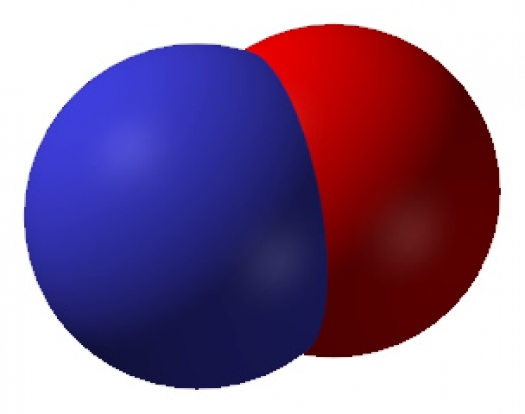nitricoxidemolecule.jpg

Illustration by Ben Mills, public domain / Wikimedia Commons
In 1992 Nitric Oxide was named Molecule of the Year by the American scientific community. In 1998, the discovery of Nitric Oxide as a critical signaling molecule was awarded the Nobel Prize in Physiology/Medicine.
The relatively recent Nobel Prize awarded for the discovery of Nitric Oxide (NO) was momentous and has resulted in major advancements in many clinical areas. This discovery was viewed as so fundamentally important that NO was named “Molecule of the Year” by Science in 1992. To date, it’s become the most heavily studied molecule with over 130,000 published papers devoted to understanding its role in health and disease.
It is well-documented that the most prevalent cardiovascular, metabolic and cognitive disorders impacting healthcare are largely the result of the loss of available nitric oxide in the body. NO deficiency is the basis for endothelial dysfunction which underlies the development of these disorders that plague the population. Consequently, NO is considered the molecule that now offers the means for profoundly altering the disturbing trends in public health.
NO is a gas produced naturally in the body and serves as one of the most important signaling molecules in mammalian physiology. First described as endothelium-derived relaxing factor (EDRF), NO is produced in the vasculature and diffuses into the underlying smooth muscle of the blood vessels causing relaxation. This results in vasodilation and an increase in blood flow and oxygen delivery. NO is considered the Master of Homeostasis in the cardiovascular system, controlling inflammation and preventing abnormal activity such as leukocyte adhesion to the endothelium, platelet aggregation and other events leading to atherosclerosis.
NO is made by immune cells in host defense and is a neurotransmitter in the nervous system. It is the key to sexual health both through genital innervation and vasodilation in men and women. NO regulates the mitochondria and activates stem cells and telomerase in support of healthy aging. There are emerging studies providing a clear association between the loss of sufficient NO and the development of chronic conditions such as Atherosclerosis, Type 2 Diabetes and Alzheimer’s disease.
In view of the clinical science, it appears vitally important for all healthcare practitioners to become well-educated about nitric oxide. We now recognize and appreciate that the body’s production of NO declines progressively with age but that this loss is certainly accelerated by unhealthy lifestyles. Factors such as modern inflammatory diets, lack of exercise, chronic stress and environmental challenges such as chemical exposures, can negatively impact the ability to produce and maintain physiological levels of NO. Loss of NO provides a plausible explanation for the link between these factors and the rise in chronic disease rates globally. The loss of NO, at any age, is being defined as the earliest event in the onset and progression of chronic disorders. This makes NO restoration a primary consideration in the patient evaluation and feasibly the first target of therapy.
Restoring the body’s own production of NO or providing an exogenous source is an attractive therapeutic option. Development of NO-based drug therapies that imitate the body has been challenging, slow and mainly unsuccessful due to many factors that involve the precisely-controlled regulation and production of NO in virtually all biological systems. However, strategies designed to provide the body with substrates or precursors of NO that will activate under specific conditions should be the goal of nitric oxide-based therapy. This puts production of NO under local regulation, similar to our physiology. This alternative or integrative approach is critically valuable for patients in the prevention and amelioration of chronic conditions.
The Pathways to NO
L-arginine Pathway
The L-arginine pathway for NO production was the first route to be discovered and led to the early use of supplemental L-arginine to increase NO production. However, it is now recognized that in conditions associated with inflammatory imbalance, the nitric oxide synthase (NOS) enzymes of the L-arginine pathway become dysfunctional, contributing to NO deficiency.
This explains why L-arginine supplementation is largely ineffective, particularly in the population over 40 years old. In fact, age related decline in NO production, termed endothelial dysfunction, is due to the inability to convert L-arginine into NO. Therefore, the strategy of supplementing with L-arginine generally does not work as a means to effectively replete NO levels to optimum. This is because L-arginine is not the rate-limiting factor as once believed, rather, it is NOS cofactor availability and oxidative stress that are the limiting factors.
Administering L-arginine to a “broken” system can create more inflammation because the dysfunctional, uncoupled NOS enzymes may begin to generate superoxide radicals instead of NO. In particular, L-arginine should not be recommended following acute myocardial infarction (MI) or in peripheral artery disease (PAD) because it has not demonstrated benefit and may increase post-infarction mortality (VINTAGE – Schulman, et al. 2006; Wilson, et al. 2007).
Nitrate-Nitrite-NO Pathway
As NO science progresses, the recently discovered nitrate-nitrite-NO pathway has moved to the forefront. This pathway utilizes the anions, nitrate and nitrite, that come from the breakdown (oxidation) of endothelial-derived NO in the L-arginine pathway but also from dietary inorganic nitrates found abundantly in certain green leafy vegetables and beets. This complementary pathway can be safely manipulated to restore NO and is the focus of increasing study. Nitrate and nitrite represent a major storage form of NO in both blood and tissues that can convert to NO and also protect the body from hypoxic tissue injury. These anions increase NO availability, which supports a corresponding improvement in endothelial NO production. Studies show that restoring NO in the lumen of blood vessels facilitates the regression of plaque deposition along with improving elasticity and compliance of vessels as a manifestation of endothelial rejuvenation. This leads to improved clinical outcome in many areas of health. The implications of these discoveries and observations are what will eventually change the medical paradigm to a focus of prevention and remediation, not simply disease management.
N-O measurement that can be easily performed in the office setting is also necessary to screen large populations of patients. Currently, measurement of nitric oxide sufficiency is still not part of the standard chemistry testing routinely used for diagnostic purposes. This is simply unacceptable given the critical nature of N-O in many serious health conditions. Recent innovations in diagnostics have unveiled a non-invasive, semi-quantitative salivary test strip that can be utilized as a means to monitor total body NO availability.
Understanding the endogenous pathway for metabolizing nitrate and nitrite to NO is the new frontier and promise for NO restoration. In the US, the University of Texas Health Science Center in Houston is leading the way in NO research based on the nitrate-nitrite-NO pathway and has several patents for novel strategies to both diagnose and safely and effectively restore NO in the human body.
There are revolutionary advancements occurring in NO science and there is much to learn. We encourage alternative and integrative practitioners to become proactive in this education. Although NO drug development is furiously underway, you are presently years ahead in being able to safely help your patients and protect yourselves and your families from the deleterious effects of insufficient nitric oxide.
For more information, visit Neogenis Medical.


